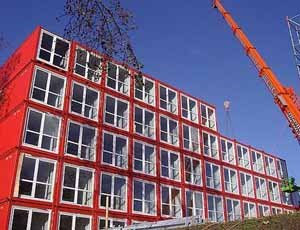
I’ve been looking at a shipping container home myself as I’m keen to have an out-of-town property, possibly in the Hunter Valley, and a shipping container would be an ideal and very economical solution as well as being very different from the type of houses I’ve built in the past.
My creative juices are flowing!
Modern shipping containers are built to withstand extreme conditions and so are ideally suited for habitation. While the use of shipping containers for temporary shelters have been at the margin of society for years, architects and those interested in sustainable housing are returning to the use of these strong and inexpensive structures as cheap building blocks.
Modified containers are almost indestructible and they are also resistent to mould, fire, termites and extreme weather conditions. It is important when buying a shipping container to live in that you check to see what was previously transported in it and take any steps to de-contaminate if used for chemicals or other toxic materials before you convert the space.
Container City was designed to be low cost, as well as environmentally friendly and recycled materials made up 80% of building supplies. Architect Nicholas Lacey and partners and engineer Buro Happold used component pieces to build up adaptable living and work spaces.
Container City I was a such success that in in 2002, Urban Space Management added an addition, dubbed Container City II. Reaching five stories high, Container City II is connected to its earlier iteration via walkways. It also boasts an elevator and full disabled access, as well as 22 studios.
Photo: Keetwonen Complex, Amsterdam
Another project billed as the largest “container city in the world” is Amsterdam’s Keetwonen complex. This project houses 1,000 students who are very happy to be able to live in the city in what is a very tight real esate market. The project was designed by Tempo Housing in 2006 and is said to be a huge success with all units well insulated, very quiet and comfortable with a bedroom, kitchen, study area with large windows and a balcony. The complex even has central heating and a dedicated bike path.
Photo: The Eco Pod






